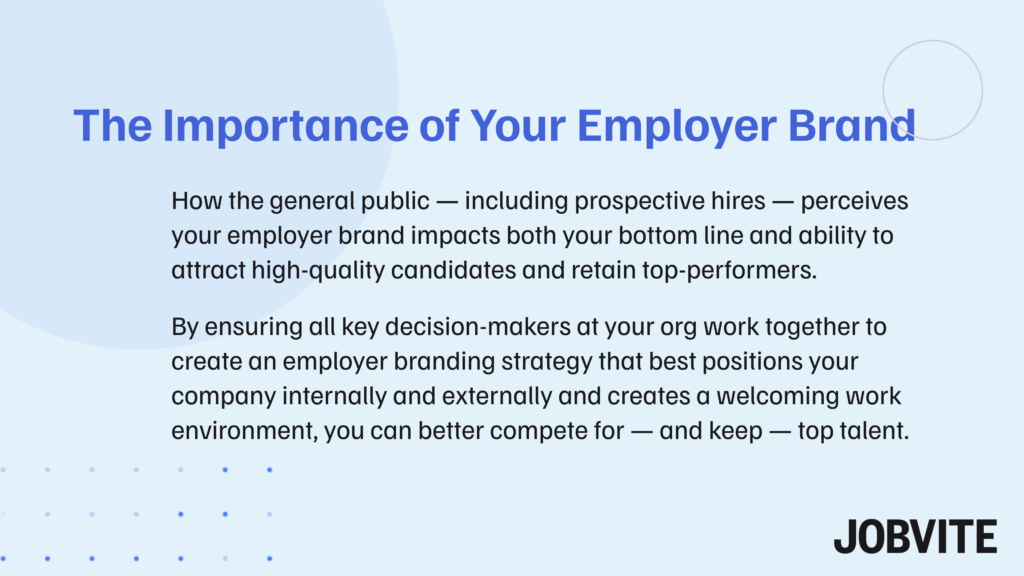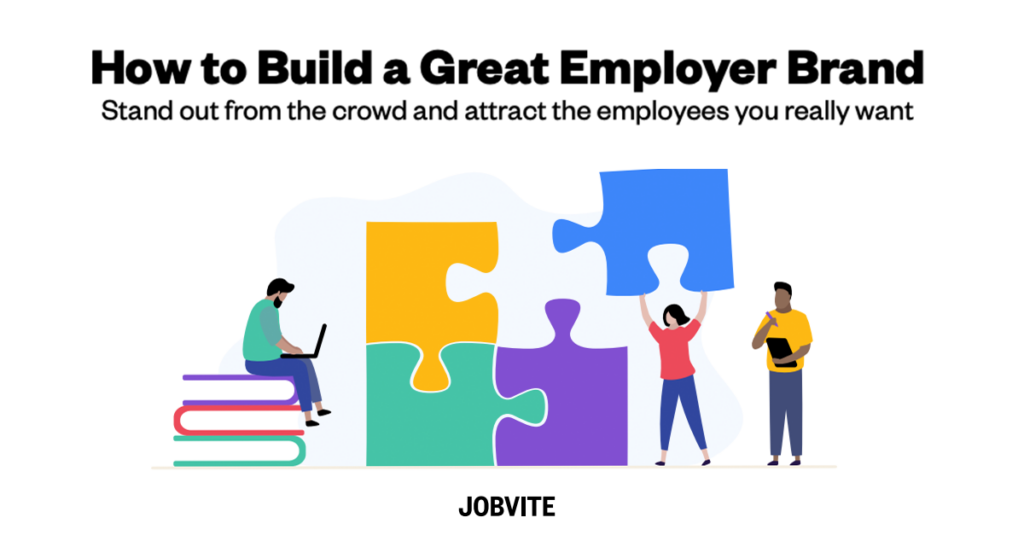Would you work with a company whose employer brand has been described by once-engaged job candidates as “deceptive,” “unethical,” or “poorly managed”? Most people wouldn’t. In fact, many enterprise business leaders would be terrified to hear their business described this way.
And yet, look at reviews of orgs on Glassdoor, Indeed, and similar online career communities, and you’ll find comments with adjectives like the above — ones that every job seeker looking for new work on said platforms (and others like them) can see when evaluating prospective employers.
In short, a strong employer brand is your path to attracting and retaining high-performing talent — individuals who can both impact your bottom line for the better and become brand evangelists.
The key to building your employer brand strategy and regularly enhancing your employer value proposition (EVP) in general is to work alongside other hiring stakeholders in your C-suite.
What is your employer brand?
Employer branding refers to the way orgs differentiate themselves from competitors in the market for employees and share distinct info about their business at large, company mission, and culture.
Simply put, companies with a strong employer brand do a great job of explaining why they’re a great place to work, how they empower employees to thrive and grow in their careers, and even what they do to be a socially conscious company (e.g., take part in eco-friendly initiatives and volunteering).
Conversely, companies with a bad employer brand struggle in these areas and, thus, tend to have a worse reputation than businesses that excel with good employer branding strategies.
To understand the current state of your employer brand perception, ask yourself:
- What is your company’s reputation among your workforce?
- What do candidates say about your brand after applying for a job and interviewing?
- How is it as a place to work? Is there a strong work-life balance?
- Do your employees feel cared for, seen, and heard by leadership?
- Would your employees recommend your company to their friends?
Examining the online real estate your business occupies — from your careers page, to your social media presence — can also help you discern whether your employer brand is enviable or dreadful.
Remember, though: No one person is intended to actively manage and enhance your employer brand. It’s a true team effort your executive team — including your HR and talent acquisition leaders — should be involved with. Even DEI committee members and ERG leaders can help.

4 ways to improve your employer brand
The biggest hurdle most leadership teams face with elevating their employer brand is determining how to best address and improve their candidate experience (and, in turn, their online reviews).
Here are four ways to approach your employer brand online to attract top talent.
1) Evaluate your digital presence
Uncover all reviews from current and former employees and previously engaged job candidates. Read each one of them to discover what’s being said — for better or worse — about your org.
Luckily, Glassdoor reports that the majority of their reviews are actually positive. Going through this process could be an insightful way to discover your strengths as a hiring company.
Moreover, you’ll be better prepared to lean into them when working to attract top talent.
- What do your online reviews reveal about your employer brand and workplace culture?
- Is it the brand description you hope to convey, or is it skewed slightly, in your opinion?
This process could only entail a minor pivot to align with your brand goals, or it could involve a more thoughtful conversation internally. Either way, the importance of this step can’t be overstated.
2) Respond with intention
Be gracious to those who took the time to leave positive feedback. This perpetuates your positive employer brand and encourages others to leave positive feedback as well.
Respond humbly and thank the reviewer for the message. Make a point to mention how you’ll look into their concerns or suggestions and then follow through.
Negative reviews happen (and aren’t ideal), but today’s job candidates will put more stock in a company’s response than the review alone.
The three critical steps to facing a negative review: thank the reviewer earnestly for their feedback, state how seriously you take their concerns and suggestions, and make the offer to continue the dialogue through a private medium.

3) Create a culture of responsive communication
Start laying the groundwork to avoid candidate complaints by improving your candidate experience. When seeking to create positive candidate experiences, communication is key.
Unfortunately, too many recruiters and employers treat the hiring process as a one-way street, requiring prompt answers and updates from candidates without offering the same thing in return.
Services like candidate texting and automated intelligent messaging make providing candidates with real-time, helpful feedback easier.
Communicating details on next steps they must take or just acknowledging when their application has been received and reviewed leaves fewer unanswered Qs and room for competition to sneak in.
4) Share clear expectations with candidates
Hand-in-hand with keeping candidates in the loop during the hiring process, it’s equally important to let candidates know what to expect if they are hired. That means offering them a clear and detailed glimpse of their new role’s responsibilities and your company’s unique culture.
Ask most job seekers today, and they’ll tell you they believe that good company culture and overall work environment is essential to business success. So, demonstrate what makes your culture stand out from those of other employers, and you will be ahead of the game.
When does your candidate experience end? After you decide not to hire them, right? Wrong.
Just because a candidate isn’t right for the role you currently need to fill doesn’t mean they won’t be right for a different role in the future.
A good way to improve candidate experience is to keep in touch with all high-quality candidates, not just the ones you hire. Instead of starting over from scratch, you may already have dozens of prime candidates sitting in your recruitment pipeline.
Communication shouldn’t stop once the candidate has accepted an offer. To ensure a smooth onboarding process, ask yourself the following question:
- Is your onboarding experience seamlessly connected to your hiring experience?
- Are all of your new hire forms digital so that new hires don’t have to fill out forms by hand?
- Do you have an onboarding portal that prioritizes all of a new hire’s tasks?
- Does your onboarding portal work on mobile?
- Do you offer pre-boarding? In other words, is your onboarding portal available to candidates before they start, so they can get a headstart on the process?
At the end of the day, it’s the small interactions and personal touches that make candidates feel valued, respected, and appreciated. And those are the things they they’ll remember long after the recruitment process is over, even if they don’t end up joining your company.
Strengthen your employer brand and talent acquisition efforts at large with our Evolve Talent Acquisition Suite for enterprises. Schedule a one-on-one demo with our team today.





